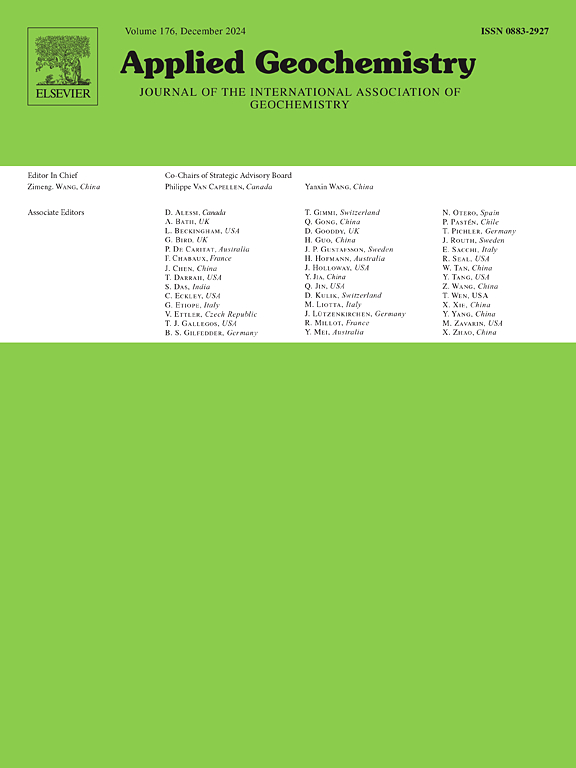Use of near-surface waters in identifying elemental associations with geothermal-sourced Li
IF 3.4
3区 地球科学
Q1 GEOCHEMISTRY & GEOPHYSICS
引用次数: 0
Abstract
Unprecedented demand for lithium (Li) is being driven by its use in electric vehicle batteries. Currently, the majority of Li comes from pegmatite mining and salar brines, however, new sources such as geothermal brines will be required to meet future demand. The North Pennines, Northern England has been found to host brines with lithium concentrations exceeding 90 mg/L from 411 to 995 m. However, deep subsurface water chemistry for the region is limited to a single abandoned borehole, necessitating the use of other techniques in assessing the resource potential of these brines. This work investigated the potential of surface and near-surface water samples from abandoned mine workings to expand the known geographic extent of the underlying Li brine resource. Li concentrations were 1.9–784 μg/L at the 44 locations sampled. Principal component, cluster, and covariate analyses identified two distinct water chemistry clusters mostly related to dimension 1 of the PCA (22.5 % of variance) and included alkalinity, Ca, Cd, Cl, F, K, Li, Mg, Na, Se, and SO42−; the “near surface” or potentially orebody related group which included Al, As, Cu, Eu, Fe, P, Pb, V, and Y. Two smaller clusters are present on the positive and negative axis of dimension two (14.1 %); on the positive is B, Ba, Br, Cr, pH, and Si, and on the negative, Co, Mn, Ni, Sc, Sr, and Zn. The Cambokeels Mine, 0.5 km from the original borehole, had the highest Li concentration of 78.4 mg/L. However, the deep brine signature and Li enrichment were also found at a cluster of mines 15 km away, significantly expanding the geographical extent of the North Pennine Li brine resource. These findings show that relatively low-cost elemental analysis and statistical analyses could be a promising exploration tool for regions where there is limited data. Developing tools using geochemical finger printing of near-surface waters to identify Li resources in deeper geothermal brines will be essential for the cost-effective development of critical minerals.
利用近地表水识别元素与地热源Li的关联
锂在电动汽车电池中的应用推动了对锂的空前需求。目前,大部分的锂来自伟晶岩开采和盐卤,然而,新的来源,如地热卤水,将需要满足未来的需求。在英格兰北部的北奔宁山脉,从411到995米的海水中发现锂浓度超过90毫克/升。然而,该地区的深层地下水化学仅限于一个废弃的井眼,因此需要使用其他技术来评估这些盐水的资源潜力。这项工作调查了废弃矿山地表和近地表水样的潜力,以扩大已知的下伏李盐资源的地理范围。44个采样点的Li浓度为1.9 ~ 784 μg/L。主成分、聚类和协变量分析确定了两个不同的水化学聚类,它们主要与主成分分析的维度1相关(方差为22.5%),包括碱度、Ca、Cd、Cl、F、K、Li、Mg、Na、Se和SO42−;“近地表”或潜在矿体相关组,包括Al、As、Cu、Eu、Fe、P、Pb、V和y。两个较小的簇在维度2的正、负轴上存在(14.1%);正极是B、Ba、Br、Cr、pH和Si,负极是Co、Mn、Ni、Sc、Sr和Zn。距离原钻孔0.5 km的Cambokeels矿的锂浓度最高,为78.4 mg/L。而在15 km外的矿区群中也发现了深部卤水特征和富集,大大扩大了北奔宁地区李盐资源的地理范围。这些发现表明,相对低成本的元素分析和统计分析可能是数据有限地区的一种有前途的勘探工具。利用近地表水的地球化学指纹技术开发工具来识别深层地热盐水中的锂资源,对于经济有效地开发关键矿物至关重要。
本文章由计算机程序翻译,如有差异,请以英文原文为准。
求助全文
约1分钟内获得全文
求助全文
来源期刊

Applied Geochemistry
地学-地球化学与地球物理
CiteScore
6.10
自引率
8.80%
发文量
272
审稿时长
65 days
期刊介绍:
Applied Geochemistry is an international journal devoted to publication of original research papers, rapid research communications and selected review papers in geochemistry and urban geochemistry which have some practical application to an aspect of human endeavour, such as the preservation of the environment, health, waste disposal and the search for resources. Papers on applications of inorganic, organic and isotope geochemistry and geochemical processes are therefore welcome provided they meet the main criterion. Spatial and temporal monitoring case studies are only of interest to our international readership if they present new ideas of broad application.
Topics covered include: (1) Environmental geochemistry (including natural and anthropogenic aspects, and protection and remediation strategies); (2) Hydrogeochemistry (surface and groundwater); (3) Medical (urban) geochemistry; (4) The search for energy resources (in particular unconventional oil and gas or emerging metal resources); (5) Energy exploitation (in particular geothermal energy and CCS); (6) Upgrading of energy and mineral resources where there is a direct geochemical application; and (7) Waste disposal, including nuclear waste disposal.
 求助内容:
求助内容: 应助结果提醒方式:
应助结果提醒方式:


